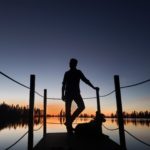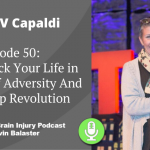How I Found Balance Through Yoga: Hot Power Fusion
Yoga is hard! At least it is for me. It was already difficult for me to articulate physically what most people take for granted, therefore yoga posed an incredible challenge for my inadequate balance. The instructor (or guide) tells everyone in each class to take as many breaks as desired at any point throughout the class. However, I am far too stubborn to rest unless I absolutely feel the need to. Thus, I would attempt to stand on one leg while my other leg caught my balance every half a second or so as sweat dripped from my nose and poured down my forehead, soaking my thin t-shirt within 5 minutes and leaving me panting.
Nani and Mindy are both instructors at the studio and did one assessment and pose modification session with me; they did not even charge me for the assessment. During this assessment it became clear that I needed to be near one of the walls in order to brace myself for a number of poses. I could do most poses that allowed my hands to be used as a support on my mat by this time, but was unable to keep my balance when attempting all of the standing poses. In fact, the first pose, which is considered to be the most simple one, was extremely difficult for me. This pose is to simply stand with both feet together with eyes closed and, for me, my entirety became unstable the moment I shut my eyes. It is very surprising and noteworthy that vision holds such a strong influence on balance.
Despite the intense discomfort, yoga provided a feeling of accomplishment for me, because I felt myself improving at what is considered to be a difficult expression of the body. During this time I would say to myself and others around me: “I think that yoga is the most effective and least expensive therapy I have.” And my notion turns out to be supported in peer reviewed literature: It has been proven that the cardiovascular workout involved in the practice of yoga and its challenging positions increases brain function (Effects Of Yoga On The Brain); additionally, the balance and control needed to perform these positions strengthened my balance. Finally, the interspersed moments of complete relaxation allowed me to clear my mind, to disconnect from the external turmoil and negative discourse I had been facing since my injury.
Whenever Mindy would guide a class, she would always start the class with a moment for everyone to set an intention for our time. It took me a while to even know what an intention was, let alone MY intention. I would assume that an intention is the same as a goal at first, thus I would think of what I wanted to change about my physical condition and ask myself what I needed to improve in order to get better. For example, my “intention” would be to have better balance or the ability to run. But as the months passed, at one point, the question I asked myself changed: “what would you like to get out of this class realistically. Without being attached to a physical improvement?”
I like how the word “intention” is used here instead of “goal” because a goal and an intention have very important but subtle differences. Despite these differences, and because I did not understand them, I was thinking of my goals. A goal is the outcome desired in the future: the destination that one aspires to. A goal plays an important role to structure, organize, and prioritize activities based on that desired destination. Unlike a goal’s focus on the future outcome, an intention takes place in the present and is not concerned with the future; hence, there is no attached feelings of longing for the yearned outcome. The calm brief moments of relaxation throughout gave me a moment to truly contemplate my intentions with each class. And my intention was simple and would always be the same: clarity.
I wasn’t thinking straight and I felt like “my brain was broken” still. I just wasn’t even close to as sharp as I once was. In fact, I was so unclear that I couldn’t even see that I was unclear. How can one tell that it is raining when they are under water? With so much mind fog, I was not even aware that there was a fog.
Clarity became everything to me because once I could see that I was unclear, I realized that I had been in a haze ever since my brain injury. I don’t know exactly what I thought throughout my delusional audacity, but in retrospect I feel as if my arrogance may have actually given me enough false confidence to press on. As the fog cleared enough for me to realize that there was a fog, I knew that if I could find clarity, I would be able to clearly see where my next steps were going to be. The first step to solving a problem is defining that problem, and it is impossible to define something that one cannot wholly perceive. I needed to begin looking forward, one step at a time in the right direction, rather than focusing on the destination.
Yoga is a practice. A practice is an activity that one performs (or attempts to perform) throughout a lifetime in order to improve. There is no end. It’s like martial arts in this sense: one does not simply say that they are the best that they could be, because a martial artist, a yogi, or an athlete of any sort, for that matter, would never believe that. There is always room for improvement. And even to sustain abilities, one must practice those abilities regularly.
It seemed as though with each class I would get better. Perhaps it was everything involved in yoga, and I’m not the kind of person to use the word “spiritual” very often… I’m more of a realist; but even as a realist, the spiritual aspect seemed to be especially therapeutic. The idea of getting in touch with not only the body, but also the mind and especially the connection between them: the mind body connection.
The connection between my mind and body was what I was most severely lacking. I would tell my hand to pick up a pen, for example, and twirl it between my fingers. This is a task that was easily done with my right hand, but I could not convey this previously simple task to my left hand and fingers. Another example is how I would tell myself to stand with my eyes closed, but I would immediately lose my balance and needed to open my eyes and catch myself so that I wouldn’t fall and possibly hurt myself. Some of the connections between my mind and body had been damaged.
Building these new connections required the repetitious trial of these tasks and frustrating failures with each attempt which showed only tiny improvements over time. But these tiny improvements gave me hope and, therefore, the will to continue trying. After months, I found myself weening off of my reliance of the wall to support me when standing on one leg and doing some of the poses. I was regaining my balance. And I was recovering the clarity that defined my intention.
Other links about the effects of cardiovascular exercise on the brain:
http://www.ncbi.nlm.nih.gov/pubmed/17037089
http://en.wikipedia.org/wiki/Effects_of_physical_exercise_on_memory




Comments
We have the same condition. I suffered cardiac arrest in October 2011. I was inpatient rehab for 2 months. I tried yoga early on but was very limited. Balance also is my primary challenge. I’m trying to return to swimming (coordinating the specific , various motions is very difficult) . I’ve just this morning (!) Returned to yoga with my wife’s teaching. My question for you is, how did you discover you were in a “fog” and how would you describe being in the fog vs being outside it?
Hi Keith,
Describing brain fog is difficult to do or relate to, especially when one is in a fog. I suppose one doesnt know it until they are out of it. I guess I would describe it as a deep feeling of not understanding things, although I would portray that I did on the surface. Deep down I knew, but didn’t know that I knew that I was unclear. Does that make sense? It hardly does to me, but I hope that helps.
Did you have a seizure? Mine was undiagnosed, but after they tried weening me off of oxygen and my involuntary reaction was to bite down on my tube, stopping all oxygen to my brain and body, I desaturated to 60% of the oxygen that I should have had. The medical reports say that I stopped moving my left side after that, so I must have had a hypoxic stroke.
Two of my posts may be helpful (one is all about balance):
1- Aquatic therapy (Out of Balance): http://cavinb.wordpress.com/2012/11/11/out-of-balance-2/
2- How food is incredibly important (Food for Thought): http://cavinb.wordpress.com/2013/02/11/food-for-thought/
Stay in touch!
-Cavin Balaster